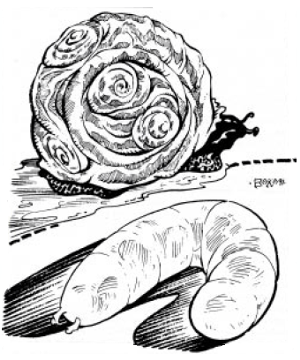Animal, Herd (Athas), Kip [252] 
| Climat/Terrain | Scrub Plains |

|
|
| Organisation | Herd | ||
| Fréquence | Commun | ||
| Diète | Omnivore | ||
| Cycle d'activité | Night | ||
| Intelligence | 1 - Intelligence animale | ||
| Trésor | See below | ||
| Alignement | Neutre Absolu | ||
| Nombres | 1-100 | ||
| Classe d'armure | 4 | ||
| Mouvement |
Au sol :
6" Vol : - Classe de vol : Nage : Enfouissement : Web : |
||
| Dés de vie | 1+2 | ||
| Thac0 | 19 | ||
| Nbre d'attaques | 2 | ||
| Dommage / attaques | 1-3 | ||
| Attaques spéciales | Pheromones | ||
| Défenses spéciales | Pheromones | ||
| Résistance à la magie | Nil | ||
| Taille |
S - smaller than a typical human ( 2+' to 4' ) (2-4’) |
||
| Morale | 8-10 - Moyen | ||
| Valeur en XP | 65 xp | ||
| Commentaires :
The kip is a shy, six-legged, armored creature that digs and eats roots of plants and trees. Their supple, armor-like covering makes excellent durable leather goods. The leathered kip grows from 2’-4’ in length. Kips are covered with a horny armor that is segmented into nine separate plates. They have elongated, pointed snouts and very small, beady eyes located on each side of their snouts. The eyes are protected by a glass-like covering that protects them while digging. The sharp, strong foreclaws enable the creature to dig. Their short, stubby, hind legs only allow them to amble around slowly. Kips communicate via a series of low grunts. Although not a true language, dwarven kip-herders have learned to mimic the sounds in order to better control the herd. Kip language can be learned at a cost of a single non-weapon proficiency slot. As with other languages, a simple check should be made against a character’s Intelligence for successful communication. Failure means: 1) the kip doesn’t understand and ignores the attempted communication; 2) the wrong information is conveyed. |
|||
| Combat : Kips are generally non-combatant and prefer to amble away when approached. Thus, they are easily herded. They will only fight if cornered or to protect their young. Kips use pheromones to protect themselves. Pheromones are secreted chemicals that produce an emotional response in the victim. Once a day a kip can release an 8-cubic-foot cloud of invisible, gaseous chemicals. Creatures within the gas cloud must save versus poison or suffer apathy. If effected, the victim will cease caring about anything, including drinking water, for a period of 1d8 turns. Exposed creatures or individuals can be herded along or made to drink, but they really don’t care if they live or die. Because of their high resistance to poison and the ability to focus, dwarves are +4 on their saving throws against the pheromone cloud. | |||
| Habitat / Société : Kips bear offspring twice a year. A litter will contain 2-6 leatherettes, which mature in 3-5 months. Until mobile, the young fasten themselves to folds in the mother’s skin and ride along with her as she moves. Kip are one of the few creatures on Athas that eat brambleweed, as their armor temporarily protects them as they dig out and expose the sweet roots. | |||
| Ecologie :
Kip herds provide a staple of meat and leather goods in most dwarven communities. Roasted, an adult kip will feed two very hungry dwarves; made into a stew, the meat and broth will easily feed six. Kips and dwarves seem to be complementary in pace and temperament. Dwarven communities keep the kip herd in a slow, constant motion since kip tend to destroy roots of growing plants. Their elongated, pointy snouts and keen sense of smell aid them in their search for food. Kips will eat anything that doesn’t put up a fight, including garbage. Dwarves with animal husbandry skill can safely milk the pheromones from an adult, but the chemical will lose all potency within 48 hours. Only a small amount of pheromonal fluid can be milked from each animal. A turn spent milking a kip will produce enough fluid to create a small (one cubic foot) pheromone cloud. |